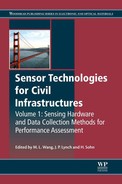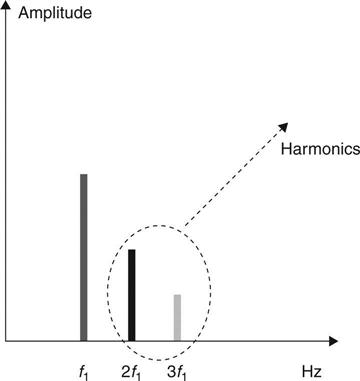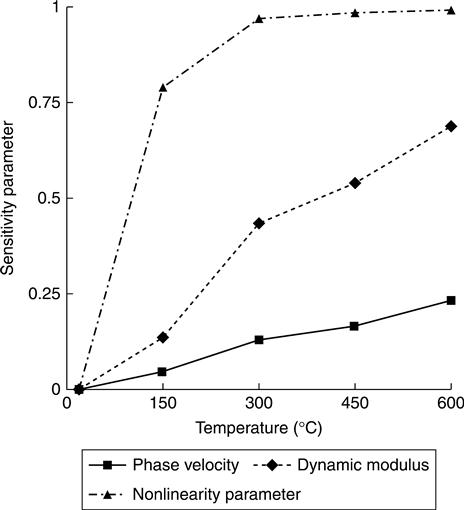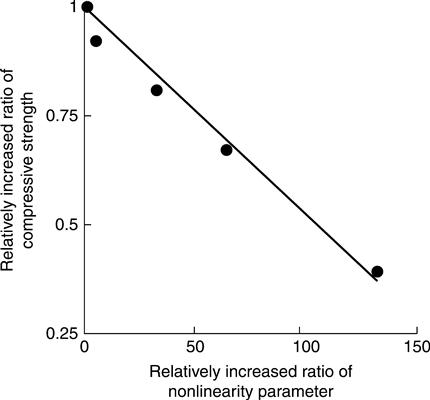Nonlinear acoustic and ultrasound methods for assessing and monitoring civil infrastructures
M. Meo, University of Bath, UK
Abstract:
This chapter presents an overview of nonlinear acoustic and ultrasound methods and their application to civil structures. The major nonlinear ultrasonic methods are thoroughly reviewed and the underlying physics and laboratory studies are reported. In particular, phenomena such as higher harmonic generation, subharmonic generation, nonlinear resonance, and mixed frequency response are discussed and the basic physical mechanism of each phenomenon is introduced with applications for evaluation of damage in civil structures. Research results to date show higher sensitivity of these techniques than the conventional linear ultrasonic methods in detecting microdamage in commonly used material for civil structures, such as concrete and mortar. Finally, current and future challenges are discussed for the successful future implementations of these methods in a maintenance programme.
Key words
nonlinear acoustic; acoustic nonlinearity; nonlinear wave modulation; nonlinear resonance ultrasound spectroscopy; harmonics
7.1 Introduction
With the rising concerns on the durability of concrete infrastructures, research in new maintenance tools and methods has drawn more and more attention from the research community. In addition, as a consequence of high cost of inspection,1 the scientific community has been trying to develop reliable and effective non-destructive technique (NDT) and structural health monitoring (SHM) tools to detect the occurrence of critical failure modes, and to estimate them at an early stage so as to reduce the risk of further catastrophic failure.
Non-destructive evaluations based on linear ultrasonic waves are well-established and reliable methods to assess flaws, defects, degradation, etc. of materials. Conventionally, linear ultrasonic methods based on phase velocity and amplitude attenuation measurements are currently used for damage assessment of civil structures because of the relatively easy procedure and underlying physics. They are based on the fact that when a wave propagates through the medium, the phase and amplitude of the wave changes according to material properties, discontinuities, flaws, etc. These variations are used to estimate damage in materials. The use of guided waves in ultrasonic inspection of plate structures has been applied successfully for the localization of defects (inclusions, delaminations, cracks), but is more complicated than conventional bulk wave inspection.2−34 This is mainly due to dispersion effects and multimode propagation. Moreover, linear acoustic/ultrasonic methods can be difficult to apply to inhomogeneous materials, such as composite materials, and in particular to damaged materials where the crack size is comparable with the wavelength. Moreover, these linear non-destructive evaluation (NDE) techniques are based on the fundamental assumption that the material constitutive behaviour is linear-elastic. However, most of the materials used for civil application, such as concrete and mortar, are not linearly elastic, even before the formation of cracks. More importantly, the nonlinear elasticity of cement-based materials increases significantly in the presence of cracks. The sensitivity and reliability of linear NDE techniques are thus not as well suited to quantitatively measuring damage in such materials as concrete.
Detailed studies of dynamic nonlinearities and hysteresis in inhomogeneous media have shown that the presence of rupture, cohesive bonds, opening/closing of microcracks, etc. in the material structure give rise to strongly nonlinear dynamic phenomena accompanying the elastic wave propagation.6 These nonlinear effects are observed in the course of the degradation process much sooner than any degradation-induced variations of linear parameters (propagation velocity, attenuation, elastic moduli, rigidity, etc.). Nonlinear parameters have proved to be very sensitive to the presence of any inhomogeneities and progressive degradation of the material structure.7
Based on these studies a new class of promising nonlinear NDE/SHM techniques are being developed where the integrity of structures is monitored by analysing the material nonlinear elastic behaviour caused by the presence of damage.8−14 Laboratory tests show that these techniques appear to be more effective than linear acoustic methods since they are able to detect microcracks long before changes of linear acoustic properties.15 In particular, research has indicated that nonlinear ultrasonic waves are quite sensitive in detecting contact-type defects, which involves clapping and rubbing of the crack surfaces.
For materials such as concrete, the acoustic properties are strongly dependent on their microstructures and presence of defects, such as grains, dislocations, cracks, etc. Due their inherent nonlinear acoustic behaviour, nonlinear ultrasonic and acoustic methods offer considerable promise in detecting damage in these materials.
This chapter presents a review of nonlinear acousto-ultrasound methods used for characterizing media and damage in materials used in civil applications, mainly concrete. The main methods covered are as follows:
7.2 Fundamentals of nonlinear acousto-ultrasound techniques
The nonlinear acousto-ultrasound techniques were originally developed to estimate the nonlinear elastic properties of heterogeneous material such as rocks. It has been shown that some damaged materials have a complex compliance and exhibit a nonlinear behaviour that cannot be explained with classic nonlinear models.17 The stress–strain curve of damaged materials may exhibit classic nonlinearity, hysteresis, and discrete memory.18 The stress–strain in one dimension in quasi-static condition can be written as follows:
[7.1]
where σ is the stress, ε is the strain, ![]() is the time derivative strain, and K is the elastic modulus. A phenomenological description of the nonlinear non-classic hysteretic elastic modulus based on the Preisach-Mayergoyz space representation describing both second and higher order nonlinearity is shown in Equation [7.2]:
is the time derivative strain, and K is the elastic modulus. A phenomenological description of the nonlinear non-classic hysteretic elastic modulus based on the Preisach-Mayergoyz space representation describing both second and higher order nonlinearity is shown in Equation [7.2]:
[7.2]
where K0 is the linear modulus, β and δ are second and third order non-linearity, respectively, Δε is the local strain amplitude, and α is a material hysteresis measure that takes into account also the history of stress through the terms sign (![]() ) and equals + 1 if the strain rate is positive and − 1 if negative. Depending on the sign of β, δ, and α, a material may soften or harden when excited with increasing driving amplitude. Some material may exhibit a reduction/increase of the resonant frequency as a function of the driving amplitude.
) and equals + 1 if the strain rate is positive and − 1 if negative. Depending on the sign of β, δ, and α, a material may soften or harden when excited with increasing driving amplitude. Some material may exhibit a reduction/increase of the resonant frequency as a function of the driving amplitude.
The term β represents the variation of the wave’s velocity resulting from the residual strain, in the case of both static and dynamic loading. This phenomenon is known as acousto-elasticity in homogeneous materials.19,20 For strongly inhomogeneous (rocks, concrete) and/or damaged materials, the non-classic nonlinearity parameter α enables hysteresis and discrete memory phenomena to be represented.17 Material used for civil applications is generally heterogeneous, exhibiting nonlinear behaviour even for low level of damage and, when damaged under large strain amplitude, may exhibit nonlinear hysteretical behaviour.
Traditional acoustic/ultrasonic NDT tries to detect variation of the linear Young’s modulus K0 caused by damage, by analysing wave speed changes, reflection of waves, linear attenuation, etc.). If damage increases, the modulus K decreases. In contrast with linear methods, nonlinear vibration-acousto-ultrasound techniques are vibration/acoustic/ultrasonic NDT that monitor the presence of anomalous behaviour (damage) by measuring and quantifying the first, second, etc. order deviations of elastic modulus from the Hooke’s law of elasticity.
7.3 Harmonic and subharmonic generation
Nonlinear ultrasonic methods often use harmonic generation to detect damage in materials. Higher harmonic generation is the classic phenomenon, where the waveform of the incident wave is distorted by the nonlinear elastic response of the medium to that wave. When sending an ultrasonic tone burst of amplitude A0 at frequency f0, the detected signal passing through the damage will be distorted and the detected wave will possess a component of amplitude A1 at the fundamental frequency f0, a component of amplitude A2 at the second-harmonic frequency 2f0, A3 at the third harmonic frequency 3f0, and so on.
Cantrell42 used the second order solution approximation of the nonlinear wave equation to obtain the following expression of the quadratic nonlinearity parameter,
[7.3]
where A1 and A2 are respectively the frequency amplitudes of first and second harmonics of the recorded time domain waveforms, k is the wavenumber, and x is the propagation distance.
Similarly the third order nonlinear elastic coefficient is expressed as43
[7.4]
where A3 is the amplitude of the third harmonics. Typically, as damage increases, the magnitude of the nonlinear interaction also increases and energy is converted from the fundamental frequency to higher harmonics. The material degradation can be therefore evaluated by measuring the non-linearity of the ultrasonic wave propagating through the target material.
The highly nonlinear elastic response can also be observed when a stress wave impinges the interface of parts in contacts. This is usually called acoustic nonlinearity (CAN). The CAN is generated by the asymmetric stress–strain relation of the interface, where the stiffness in compression is higher than in tension. This results in a strong local stiffness modulation. When a sinusoidal wave impinges an imperfect contact interface, the compressional part of the waves can penetrate it, while the tensile part tends to open the crack and therefore cannot penetrate it (see Plate V in the colour section between pages 294 and 295). Thus, after penetrating the interface, the full sine wave becomes nearly half-wave rectification generating nonlinearity. This results in high harmonics allowing a closed crack or mating parts conditions to be detected by measuring these nonlinear effects.
A parametrically driven CAN can be generated under harmonic excitation and if the driving excitation locally resonates the material, a number of fractional sub-harmonics mf/2 are generated, where m = 1, 2, 3, …. These instability phenomena, having a resonance nature, exhibit sharp dependence on crack surface variations and can be used to detect closed cracks, adhesive debonding, etc. (Fig. 7.1).7
A number of laboratory studies have been conducted using nonlinear bulk waves to detect damage in concrete structures.25,26 Concrete material is complex, characterized by the presence of microcracks due to shrinkage, and stresses resulting from curing. In particular, microcracking can develop at the interface between the cement paste and aggregate, due to mismatch of properties such as modulus of elasticity, density, moisture content, etc.
Various studies have been conducted on exploring and evaluating the physical/mechanical properties of concrete using nonlinear methods. In Reference 1 curing (phase change) of concrete has been monitored by harmonic generation. Before the thermal peak, in the liquid state, harmonics were not present. Harmonics generation and a non-classic, nonlinear dependency were observed at percolation point. A direct correlation between nonlinear response and linear response that relates to a known microstructure evolution of the connection of particles in the material was measured.
In Reference 26, the nonlinear harmonic generation was used to detect the water-to-cement ratio in concrete structures. The effect of various type of source excitation, narrow and broadband transducers, was also studied on the detected nonlinear response. It was concluded that the use of a narrowband transmitter provided greater sensitivity to damage in concrete while using broadband transducer ‘noise’ in the time domain waveforms and numerous peaks in the frequency domain spectra were observed. Both the harmonic ratios and the nonlinear parameters were found to increase as the water-to-cement ratio increased (Fig. 7.2). The increase in third order nonlinear parameters was larger than the second order parameters. This was attributed to the hysteretic material behaviour of concrete.
7.4 Nonlinear wave modulation
Another method to evaluate the nonlinear acoustic signature of damage in material is to measure the modulation of an ultrasonic wave by low-frequency vibration. Commonly, this method is known as nonlinear wave modulation spectroscopy (NWMS). Assume the propagation of two different harmonic waves through nonlinear mesoscopic elastic (NME) material, whose frequencies are different: low-frequency fL and high-frequency fH, and fH ![]() fL. If the two waves meet at a crack location, modulation occurs and new waves are measured in the output signal. The generated waves have the frequency characteristics related with fH and fL. In this case, the nonlinear coefficients β and δ can be expressed as a ratio of amplitudes given by the following equations:
fL. If the two waves meet at a crack location, modulation occurs and new waves are measured in the output signal. The generated waves have the frequency characteristics related with fH and fL. In this case, the nonlinear coefficients β and δ can be expressed as a ratio of amplitudes given by the following equations:
[7.5]
 [7.5]
[7.5]Care must be taken in measuring the amplitude terms in Equation [7.5], due to the complexity of resonant modes and the high-frequency modulation. Dislocations, rupture, cohesive bonds, porosity, opening/closing of microcracks, debonding, delaminations, etc. may give rise to classic and/or ‘non-classic’ nonlinearity effects generated by the material’s nonlinear classic and hysteretical behaviour.16 The output signais for a linear and a nonlinear material are shown in Fig. 7.3.

The physical explanation of this modulation is explained in Fig. 7.4. In the presence of a crack, Fig. 7.4a, when the structure is excited with a low-frequency vibration, a sinusoidal signal changes the width of the crack depending on the phase of the vibration. During the compressive phase of the signal the crack is closed, as long as there is sufficient energy, while in the tension phase the crack is opened. Then, the crack is excited with a high-frequency signal. When the crack is opened by the low-frequency signal, the impedance mismatch causes a reduction of the amplitude of the high-frequency signal passing through the crack. When the crack is closed by the low-frequency signal, no impedance mismatch is present; therefore the closed crack does not interrupt the ultrasonic signal and the amplitude of the transmitted signal amplitude increases. This amplitude fluctuation of transmitted signals results in an amplitude modulation of the ultrasonic signal as shown in Fig. 7.4. Fourier transformation of the excitation signal reveals new frequency components, indicating that a flaw or crack is present. In the frequency domain the wave spectrum acquires sidebands: new frequencies are created that are the sum and difference of the frequencies of the ultrasonic probe and vibration signals. This nonlinear process that is possible in undamaged materials (due to e.g., van der Waals forces in some materials) is strongly enhanced in the presence of damage. If the nonlinearity is strong enough, additional sidebands can appear, thus forming a complex modulational spectrum.
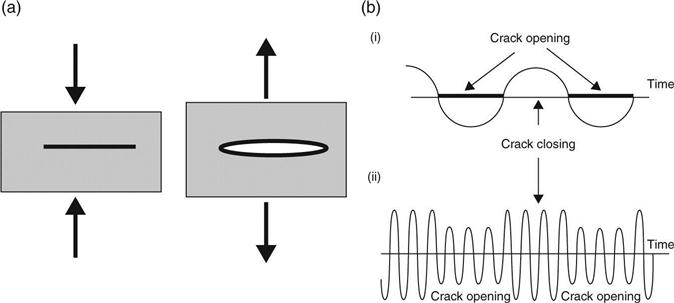
In the presence of cracks, defects, etc. in materials such as concrete, composite material3 sidebands and harmonics of the excited frequencies are generated. Crack, voids, etc. act as multipliers and nonlinear mixers of the excitation frequencies. If a material shows classic nonlinear behaviour, both harmonics and sidebands can be generated. For purely hysteretical damaged material such as concrete, odd harmonics8 are present with a much higher amplitude with a quadratic behaviour with the fundamental strain amplitude. Moreover, for damaged material, by inserting two frequencies f1 and f2 with amplitudes A1 and A2, a second order sideband f2 + 2f1 with amplitudes proportional to α A1A2 will be generated.
This behaviour is typical for rocks and material used for construction.
Nonlinear wave modulation of acoustic waves was studied in Reference 35 for the evaluation of damage in concrete structures. The results showed that both active and passive modulation (spectral analysis of regular dilatational ultrasonic signals) of probe frequencies contain nonlinear parameters; however, the active modulation was more sensitive to early concrete damage. The underlying generation phenomenon of this nonlinear behaviour was attributed to the fact that in concrete structures, stresses are not evenly distributed throughout the material due to its heterogeneous nature. This results in the formation of small cracks and stress redistribution even at low loads from the presence of processing flaws or material imperfections.
The feasibility of using nonlinear ultrasonic techniques to track the progress of damage in alkali-silica reaction (ASR) in cement-based materials was studied in Reference 34. ASR is a chemical process occurring in cement-based materials (mortars, concretes, etc.), wherein the siloxane groups (Si-O-Si) of the siliceous mineral components in the aggregates are attacked by hydroxyl ions and generate an alkali-silica gel that swells in the presence of water from the surrounding material. This reaction occurs in four stages: (1) gel formation, (2) internal pressure build-up, (3) microcrack initiation, and (4) crack growth. In presence of cracks produced by ASR, the durability of a concrete structure’s service life can be drastically reduced.
A co-linear wave mixing method for assessing ASR damage was employed by sending two longitudinal waves f1 and f2, and a new longitudinal wave with a lower frequency was generated f2–f1.The amplitude of this new wave was proportional to the acoustic nonlinear parameter β which was obtained from the frequency spectrum of the newly generated longitudinal wave. The results showed the correlation of the measured acoustic nonlinearity parameter to ASR damage in concrete, even in its early stages, provide the spatial variation, and allowed identification of the different stages of ASR damage and tracking of the intrinsic characteristics of the ASR damage (Fig. 7.5).

Unlike other expansion-based methods used to assess ASR, the nonlinear modulation method was found to be not dependent on the expansion of the concrete bar.
The degradation of mechanical properties was studied in Reference 36 using an impact-modulation technique to measure nonlinearities due to thermal damage. A comparison between nonlinear modulation with the linear ultrasonic method, phase velocity and dynamic modulus measurement was conducted (Fig. 7.6). The nonlinearity parameter and the phase velocity and dynamic modulus follow different trends as a function of the thermal damage. The phase velocity and dynamic modulus follow a linear shaped curve, while the nonlinearity parameter increases sharply for low thermal damage then reaches a plateau.
The results showed a higher sensitivity of the impact-modulation method in detecting early stage of damage of an order or magnitude. This is justified by the fact that lower thermal damage is characterized by contact-type defects, while in increasing the temperature the opening of pores is such that contact-type defects are not activated and it behaves in a linear fashion. As a consequence, linear methods become effective.
Optical microscopy showed clearly the opening and pores due to the hygrothermal physical effects and chemical dehydration (Fig. 7.7a and 7.7b). These opening and pores at the micro-scale were classified as microcracks or contact-type defects. The level of thermal damage was characterized in terms of the permeable pore related to the occurrence of opening and pores, and the nonlinearity parameter was related to the increase of contact-type defects. Both quantitative measurements were compared to thermal damage and showed a similar trend.
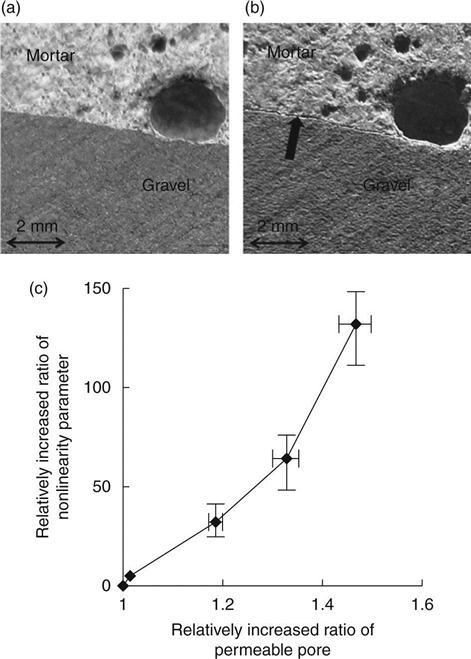
In Fig. 7.7c the relationship between the increase in pores and nonlinear parameters showed that the nonlinearity parameter was increasing with the permeable pore measurements related to the void space in thermally damaged concrete.
It was attempted to relate the thermal damage to the degradation of the compressive strength, due to generation of permanent debonding within internal components and a loss of physicochemical resistance to external stress. The correlation between the measured nonlinearity and the compressive strength of thermally damaged concrete showed a directly linear relationship (Fig. 7.8).36 This shows that the nonlinear ultrasonic method is a promising tool to provide a reliable measure of thermally damaged concrete and its residual strength.
7.5 Nonlinear resonance ultrasound spectroscopy
While linear resonance methods analyse the frequency shift due to structural anomalies, nonlinear resonance methods analyse the dependence of the resonance frequency on the strain amplitude while exciting the sample at relatively low amplitudes. In Fig. 7.9, the acceleration vs excitation frequency are reported for an undamaged and a damaged material23 when the sample is excited at a resonant frequency with increasing driving amplitudes. By analysing the frequency shift, the presence of damage in material can be revealed. For undamaged material no frequency shift can be observed, while in damaged material a frequency relative shift is evident. This method is usually referred to as nonlinear resonance ultrasound spectroscopy (NRUS).23 The term ultrasound is wrongly used for this application since the resonance modes often used are the low vibration natural modes (first, second bending, etc.).
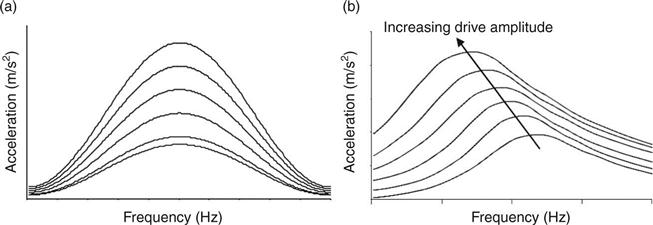
The stress–strain nonlinear model (Equation [7.2]) predicts a softening or hardening of the material with increasing driving amplitude depending on the signs of β and δ and α. In materials like concrete, the net effect is negative and the resonant frequency decreases as a function of wave amplitude. Empirical evidence suggests that the nonlinear hysteretic behaviour proportional to α dominates;37 therefore when exciting damaged materials at increasing strain amplitude level, the nonlinear parameter α8 can be evaluated as follows:
[7.6]
where ∆ε is the average strain amplitude, f0 is the natural frequency of intact material or the lowest resonance mode excited and measured, and fi is the natural mode measured for each drive amplitude, represented by the maximum value of each curve shown in Fig. 7.9. The damage is evaluated by measuring the relative frequency shift dependence (slope α) as a function of the load (strain) amplitude. This method can also be used to assess damage magnitude or growth, as long as a baseline of a previous material state is available.
Concrete is among the most used materials for civil application. The physical properties of concrete change significantly during curing, exhibiting a phase change from the liquid to solid state. It is characterized by structural heterogeneity and, in its hardened state, caused by the reaction of hydration of the cement, concrete exhibits strong elastic non-linearity similar to rock geomaterials in general. In addition to classical Landau and Lifschitz theory,31 the nonlinear response may be physically explained at different scales by dislocations, opening/closing of microcracks, recovery of intergrain cohesive bonds, porosity, etc. Hysteresis in the pressure strain response, the phenomenon of slow dynamics (time-dependent recovery of elastic properties to its initial value after being softened by large strain), and exhibit end point memory were experimentally measured in Reference 29.
In Reference 37 thermal damage in concrete structures was induced and the nonlinear parameters were measured as a function of the damage. A visible shift in resonance frequency was observed and the nonlinear parameter measured as a function of the damage temperature, derived from equation (the slope of the dotted straight line), showed a dynamic range ten times greater than the variation velocity of the ultrasonic waves (Fig. 7.10).

Similar studies were conducted in Reference 38 showing the high sensitivity of the nonlinear α parameter to small variations of material behaviour at the very early stages of a damage process, therefore reducing damage detection threshold (Fig. 7.11).

A nonlinear impact resonance acoustic spectroscopy (NIRAS) technique for the characterization of progressive damage introduced through the deleterious ASR was studied in Reference 39. The microcracks and debonded interfaces acted to increase the nonlinearity of concrete and to measure it, and the response of the specimen to impact loading was analysed.
The ability of the NIRAS measurements to distinguish between concrete that is accumulating damage and undamaged concrete was assessed by comparing nonlinearity data for concrete cast from the same mixture but subjected to different environmental conditions. The recorded nonlinearity for the baseline samples was very low (close to zero) while the shift in the resonance frequency for damaged samples at the same age is clearly evident (Fig. 7.12).
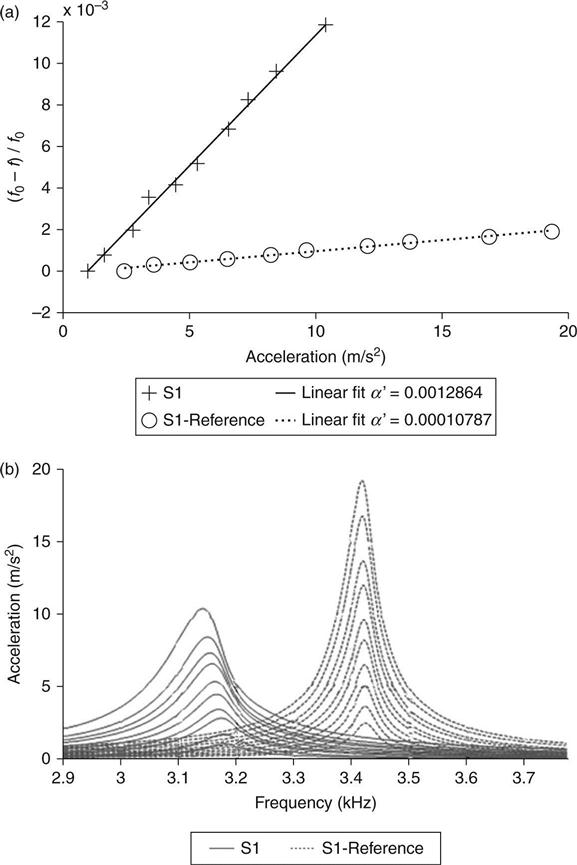
It was concluded that for potentially reactive aggregate, the technique could offer a more definitive assessment of the damage state of the specimen and could be used to distinguish marginally reactive aggregates. The results demonstrated not only a clear distinction between nonreactive and reactive aggregates, but also the capability to quantitatively track ASR-induced damage in concrete.
The NRUS methods could be the foundation of new field assessment and monitoring systems.
However, a number of challenges need to be faced before its successful implementation into an inspection programme despite its large dynamic range. First, the role of other potential parameters affecting the nonlinear behaviour should be carefully assessed and discerned from the real nonlinear behaviour caused by flaws, cracks, etc. among which there is water content, the concrete’s porosity, etc.
Then, the NRUS is based on knowledge of the resonance mode of a structure. This clearly will pose additional challenges and complexity, especially for large scale structures. Then the in situ generation of stress waves of sufficient amplitude to create a shift in the resonance frequency poses real challenges in terms of instrumentation and power needed, and reproducibility of results.
7.6 Future trends
Despite the growing interest in nonlinear-acousto-ultrasound methods for NDT/SHM of civil structures, a number of scientific and technical hurdles must be overcome for the widespread use of these methods. The main challenges to be met are:
• Nonlinear effect not related to material conditions: Presence of nonlinearities in the measured signal is often generated by a number of unwanted sources, such as instrumentation, mating parts, material inherent nonlinearities, etc. Therefore, strategies and tools for nonlinear source discrimination should be systematically adopted using rigorous measurement protocols. This will strongly help in identifying incipient material failures from spurious data.
• Nonlinear imaging. While the interest of the scientific community is strongly focused on developing linear imaging methods, there is still the need to further develop and implement nonlinear imaging methods in an SHM system.52
• Local nature of high-frequency harmonics. When interrogating a large structure to identify faults using harmonics, due to the large attenuation at high frequencies the harmonics may not propagate to the network of sensors. This local nature of ‘harmonics’ has been demonstrated in a number of studies and may limit the use of this technique for SHM applications. In the case of thin-walled structures it has been demonstrated that ‘phase matching’ will overcome this problem. When possible, sub-harmonics could be used to overcome this issue.
• Non-contact technologies. Non-contact technology could be a solution to inherent instrumentation nonlinearities. While there is an increasing development of non-contact sensors, there is still a significant deficit in non-contact excitation technologies capable of providing enough ‘linear’ energy for generating nonlinear mechanics e.g. opening and closing of cracks. This needs to be a major research area for years to come for a successful implementation of Nonlinear and Acoustic Ultrasound Methods (NAUM) for SHM of civil structures.
• Lack of physical models. Numerical models are key for the development and optimization of NAUM. Despite the effort in modelling nonlinear effects with many material models available, there is still a deficit of validated, if any, models able to predict the measured nonlinear behaviour of materials. This is due to the inherent complexity, and sometimes chaotic generation, of nonlinear features.
• Performance of permanently installed transducers. The performance of an attached/embedded system should be carefully monitored to avoid false alarms due to adhesive bonding, since this will generate nonlinear behaviour and could disguise real material changes. This, however, is a challenge for linear methods as well.
• High power needed. Because the highlighted methods need relatively higher energy (with respect to linear ultrasound methods) to induce nonlinear material behaviour, this limits the application of these methods to wired connections, unless new high energy harvester and power storage solutions are found.
7.7 Conclusions
In this chapter, an overview of nonlinear acousto-ultrasound methods for civil applications is presented. Basic principles of harmonic generation, NRUS and nonlinear wave modulation are introduced. Most of the methods discussed in this chapter assume a homogeneous and isotropic material, an assumption that is generally valid for materials used in construction. Different past and current approaches to detect and assess the severity of flaws/cracks are reviewed. A number of applications of lab applications for monitoring civil materials were discussed. Then, challenges to be faced in the future for widespread and field use of these methods are highlighted.
